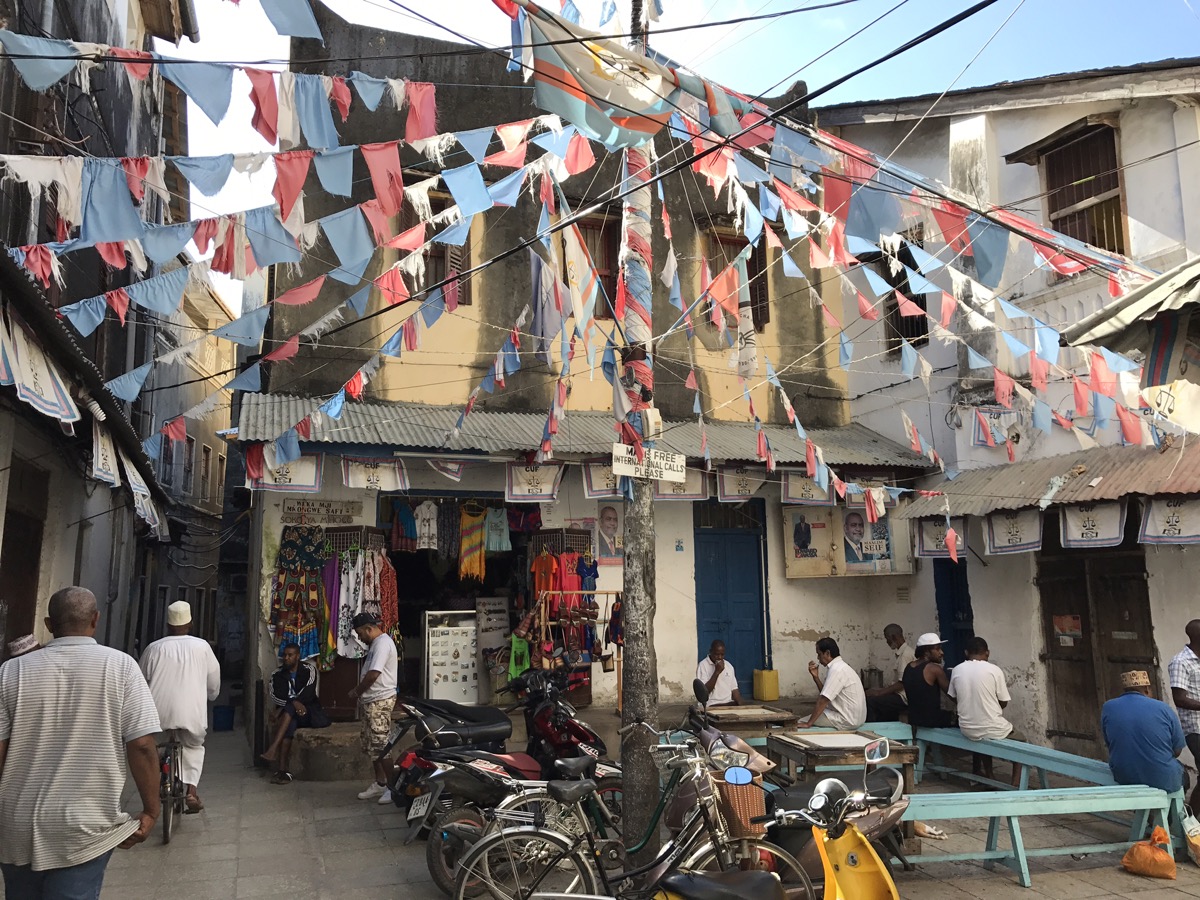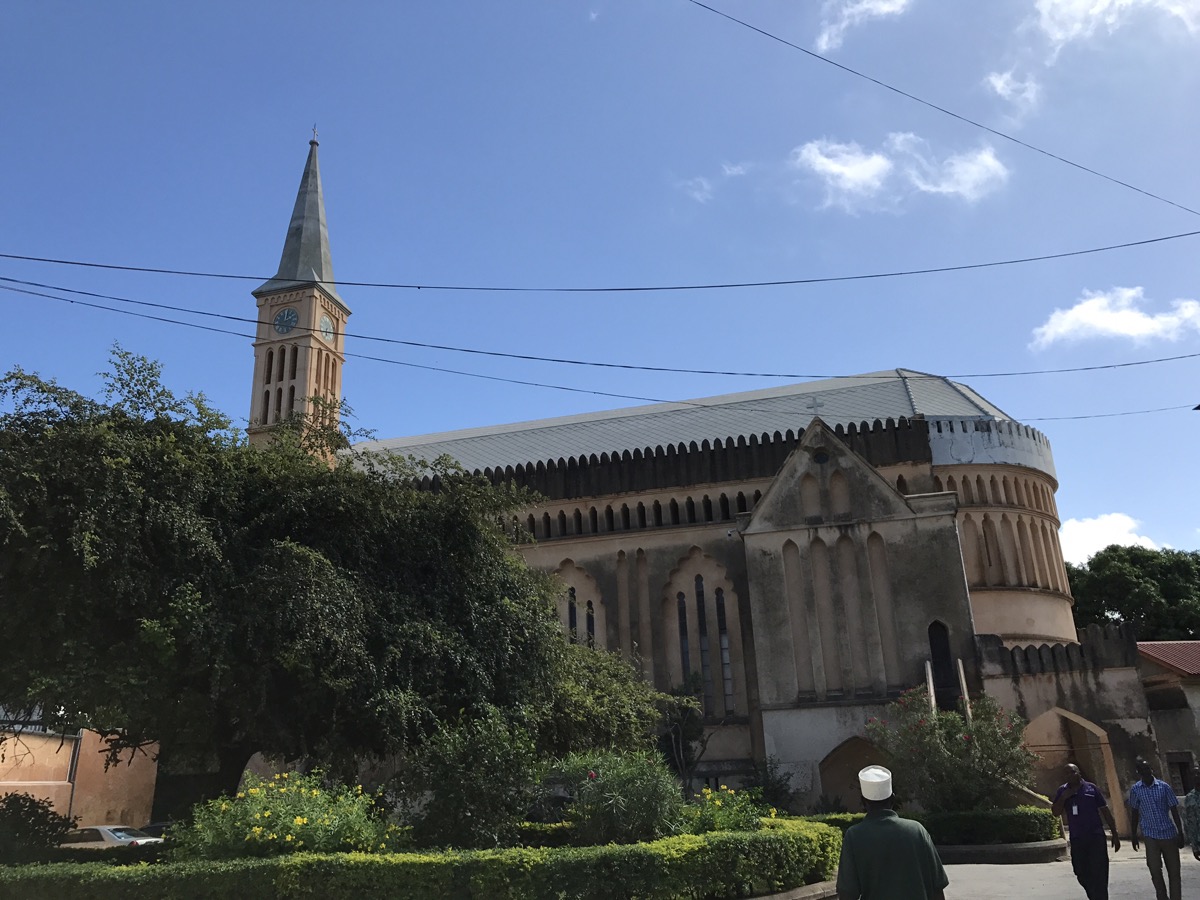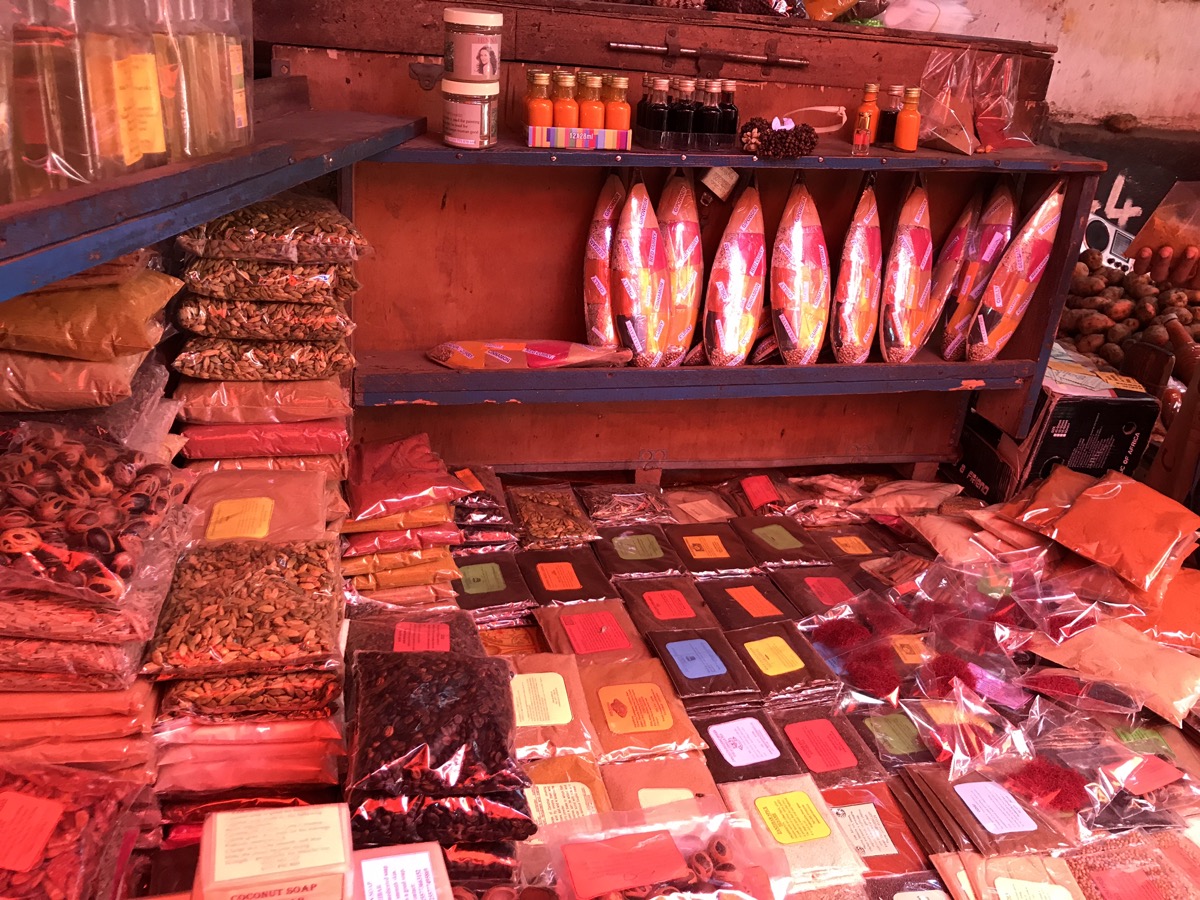We both had good sleeps and I think are now just battling colds rather than anything more sinister. We had a decent breakfast (all the usual available – fruit, croissants, hot veges, sausages and beans and omelette done to your desire or fried egg.
We met James at 9am and he introduced us to Ali who would be our guide. Ali was excellent. He pitched the tour just right. Gave us a commentary about various things and answered our questions but didn’t bombard us with information.
Stonetown is a world heritage site. It is separated from Newtown by a wide road and comprises buildings and narrow streets dating back to the 16th century. The name comes from the mixture of coral rock and limestone used to construct the buildings. Quite a few buildings have collapsed and others are under reconstruction so it is easy to see the cork in the building material.
It is possible to purchase the rock from owners of the rubble and one site had a sign up equivalent to a resource consent notice advising of what was proposed for the future. People have the opportunity to make a submission on the proposal. How familiar is that!
We had asked Ali to take us to an ATM as there is mostly payment in cash here. They have a system where you can only enter the little ATM cupboard place singly so I went in intending to get out about $600NZ which is 1,000,000 Tanzanian shillings. Unfortunately I didn’t have my glasses on and misread the number of zeros, withdrawing only 100,000 shillings. Having given Mike half my wad of cash I had a slight turn when I realised I’d used half of mine buying some sinus and cold medication at a pharmacy.
The first pharmacy we went to was a funny little place with a girl behind a window like a money exchange place. She dished out some paracetamols with a spoon from this large plastic container and I was able to buy a packet of 10 loose pills. I also got some nasal drops and sudafed equivalent. She didn’t have a replacement for my Alanase spray which was knocked off the bench and broken by the housekeeper at Farmhouse. 
We also bought some cassava chilli flavoured crisps from a shop in a lane. Th raw cassava was outside and you could buy that also. They were clearly homemade and taste just as good as anything we can buy from the supermarket.
Ali explained a lot about the architecture and history of Stonetown. It was the centre for the East African slave trade and was occupied by many Arab and Indian slave traders. It was also the centre for the spice trade. Many of the doors on the buildings are intricately carved and tell a story about the person who lived there. If the door (either mahogany or teak or a combination) is squared off at the top it is of Arab heritage. 
 If it is arched then it is Indian.
If it is arched then it is Indian.  Each of the carvings around the door also tell something about the original owner. Flowers at the top show a noble family, chains down the side indicate a slave trader and designs showing spices or fruit show specific plantation owners. Many of the Indian doors also have pointed brass knobs on them. Originally they were designed for India to prevent elephants from leaning on the doors and pushing them in but in Zanzibar they were just for decoration.
Each of the carvings around the door also tell something about the original owner. Flowers at the top show a noble family, chains down the side indicate a slave trader and designs showing spices or fruit show specific plantation owners. Many of the Indian doors also have pointed brass knobs on them. Originally they were designed for India to prevent elephants from leaning on the doors and pushing them in but in Zanzibar they were just for decoration. 
Ali also showed us how to tell a mosque. There are 60 mosques in Stonetown and 95% of the population are Moslem. There are 2 churches, one Anglican and one Roman Catholic and according to Ali everyone lives together pretty harmoniously.
Certainly it looks that way. Some of the more recent mosques have minarets and/or speakers to call the faithful to prayer but the older ones can only be identified by a bit of wall that sticks out, a bit like a chimney breast. It’s called a Kibla and is where the Imam stands. The Imam and his family normally live upstairs. There are 5 daily prayers: at 5am, 1pm, 4pm, 6.30pm and 8pm, the exact time depending on sunrise and sunset and their religious calendar. 
We went into the site of the former slave market which has been built over by an Anglican cathedral. 

There is a museum next door and the story boards about the slave trade and the slaves makes pretty harrowing reading. They have preserved a couple of the rooms where they kept 50 women for up to a week awaiting the next auction day and then transportation. Some of them suffocated to death.  The whole place floods during the rainy season and a channel through the room was the only source of sanitation. The city doesn’t flood as it is built on a slight slope and all the stormwater drains to the sea but the homes all have elevated doorsteps.
The whole place floods during the rainy season and a channel through the room was the only source of sanitation. The city doesn’t flood as it is built on a slight slope and all the stormwater drains to the sea but the homes all have elevated doorsteps.
The Anglican cathedral was built in the 1800s with construction overseen by one of the bishops. As it was nearing completion he decided to go on a safari as hadn’t done so before. When he returned he found that the inexperienced builders had installed the entrance columns upside down and evidently had a fatal heart attack on the spot. 
Some of the photos in the museum show porters carrying huge ivory tusks and 2 show some American traders sitting on top of an enormous pile of tusks. It’s a miracle any elephants survived at all.
Ali then took us to an excellent coffee shop where we enjoyed an iced latte each while he waited outside patiently. The coffees weren’t sweet and were just what we needed. They cost about $2.50NZ each.
I have noticed that there are some odd choices for clothing. Today we saw a young man walking along wearing a Santa tee shirt very similar to one that Martin was wearing one day. Another day he had a green elf tee shirt and we gave him some light hearted stick about it. The next day he asks us what an elf was and whether it was a bad thing. He clearly had no idea about elves or fairies so we described an elf as Santa’s little helper. He was very relieved to find out it was a cute, nice thing and not something awful. Evidently there’s a market in Nairobi that sells second hand British clothes and he chose them because of the colours. Presumably the guy this morning has done something similar otherwise he’s pretty early for Christmas.
After coffee we went to the site of a former fort and the former palace of a sultan.
On the way to the daily market we passed a larger pharmacy so I was able to replace my nasal spray and get some cough lollies. We came home with a regular pharmacy. The market was very interesting and colourful. It has a meat section, fish, fruits and vegetables and spices. 




 Ali brought us back to the hotel after pointing out some good restaurants to try and we have had a relaxing afternoon listening to loads of kids having fun in the pool. There are no signs prohibiting jumping or diving here! Kids having fun sound exactly the same the world over irrespective of what language they are having fun using.
Ali brought us back to the hotel after pointing out some good restaurants to try and we have had a relaxing afternoon listening to loads of kids having fun in the pool. There are no signs prohibiting jumping or diving here! Kids having fun sound exactly the same the world over irrespective of what language they are having fun using.
The maid had done our room and left towels folded up like a cute rabbit. 
Again Mike photographed the sunset and we had some ginger ale while people watching. Again many families were on the beach often with their best clothes. Some of the girls look a bit like wedding cakes.
We watched a group of teenage boys on the beach practising somersaults down into the water. They were excellent – not doing it for money or anything, though being teenage boys they lapped up the attention of their peers!
This evening we ate at an Indian restaurant Nicholas was up some steep stairs and had excellent food. Too much of it of course, though we only had 2 meals today. We get lunch on our spice tour tomorrow so I will just have fruit for breakfast.

